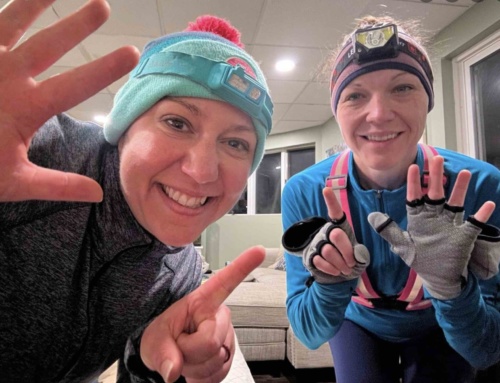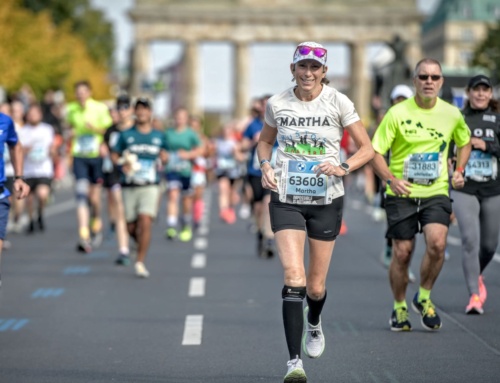Lois, now 47, started running about 4 years ago. “I woke up one day, realized I was the heaviest person in my house—my son, while sturdy, was only 11. After a few rounds of the Couch to 5K app, I wanted to go faster; even though I wasn’t really crazy about running, I liked the way it made me feel afterwards, both physically and mentally. As I went longer distances, my attitude began to change. Not only was I shocked and impressed with my ability to build distance, but somewhere around the 5-mile mark, I began to really enjoy the act of running. I’m still not fast, but I’m convinced fast is overrated. I try to maintain a John Bingham philosophy that I’m moving and that’s far better than the road I was on previously.”
Unfortunately, she hit a speed bump late last year with shin splints, so we sent her the AMR TriggerPoint Traveling Ultimate 6 Kit to help her out.
What shin splints are: a painful inflammation of muscles in and around the tibia, or front of the lower leg.
On a scale of 1 (a hangnail) to 10 (hospitalization required), I would rate this injury as a: The pain varies from a 2 to an 8 or 8.5 when I’m running. (And it hit an 18 when I tried running in compression sleeves.)
What causes shin splints: Like the majority of running injuries, shin splints can pop up when you run too far, too fast, or too hard; we love your enthusiasm, but your shins don’t. If you’re a serious pronator, your shins might seriously feel it, and if your calves are seriously tight, you’re also at risk. Running exclusively in one direction on a small track isn’t a great call, and neither is putting in excessive mileage on your shoes. In addition, you can likely have one shin that feels the brunt, and the other won’t. Runner’s World explains, “Typically, one leg is involved and it is almost always the runner’s dominant one. If you’re right-handed, you’re usually right-footed as well, and that’s the leg that’s going to hurt.”
I lost track of how many miles were on my shoes, then I increased my training mileage in anticipation of Little Rock Half-Marathon, all the while running on an indoor track where on lap was .1 mile, not .25, like it is on most typical outdoor tracks. Way too many miles on old shoes + Way too much turning = No Bueno.
What shin splints feel like physically: A shooting or stabbing pain in the inner or outer part of the shin when you run or walk. They’re not specific to one exact place, but rather a general area on the front of the lower leg. Initially, they really only hurt while running, but if you don’t pay attention to them, they can haunt you all day long.
I felt them only when running, and even then it was sporadic: sometimes I can go a couple miles before they start complaining, sometimes only a couple laps. It’s always worse on the indoor track. Outdoors running involves friends and at least some variation in terrain; I’m not sure which factor alleviates the shin splints, but it certainly makes me not want to run solo inside…
You might have shin splints if: Your shins hurt when you run and are tender to the touch. People tend to get shin splints on the inner part of their lower leg, but the outer is possible as well. Also, one good self-test from Runner’s World: Shin splints are also at their most painful when you forcibly try to lift your foot up at the ankle and flex your foot.
When the pain recurred nearly every time I ran, I knew something wasn’t right. After going through the gamut of what-might-I-have-done, I finally realized that I simply let my shoes get old. They didn’t look bad, so I hadn’t recognized the mileage they were carrying. (This is a fairly common mistake: shoes can look fresh, but the midsole—the cushioning you can’t see—can be totally worn down.)
What and how to release shin splints: I rolled shin-specific manipulations—there are two in my video, plus the soleus release—before every run. They take less than 5 minutes tops, and the tools fit in my gear bag without a problem. The first few times I did them, they made my legs very tender (I didn’t realize how tight my muscles really were…) but over time, the tenderness went away. Now I’m able to apply more pressure for a deeper massage with less pain. I did the shin-specific manipulations plus the rest of the Ultimate 6 Manipulations found in the accompanying booklet about five times a week, while watching TV before going to bed. Comprehensive TriggerPoint™ videos that go through everything shin splint-related like this one were really helpful too.
What else works physically on shin splits: Icing your shins (either with the TriggerPoint Cold Roller or by freezing water in half of a Dixie Cup, then tear away the top part and use the “popsicle” part to target your sore shins); stretching your calves; wearing the proper shoes that don’t have a ridiculous amount of miles on them (wear differs between shoes styles and runners: anywhere from 250 miles-500 miles a pair is “normal).
I tried compression sleeves, which feel great for recovery, but were absolute demon-spawn during a run. I saw my orthopedist, who is a runner. He prescribed some witch doctor voodoo magic lotion that can only be purchased from a pharmacy across state line, and which is not covered by my insurance. I made the trek. While at first I thought it was working, I think what was really working was that I was simply taking time off and spending time rubbing the voodoo medicine into my shins (sounds a little like self-massage, no?) NSAIDS are also recommended, but they don’t work for me. The only other thing that even kind of worked was rest…ugh! As Sweet Brown says, ain’t nobody got time for dat!
How I coped mentally: If the question is how I coped with shin splints, the answer is: not very well. I’m not good at rest, but the thought of another painful run was equally unappealing. My family would probably say I stayed angry.
How I’ll avoid shin splints in the future: Besides releasing my muscles regularly, I’m going to be much more careful about logging my shoe miles. And hopefully, I’ll be more willing to pull the trigger on a new pair of shoes the minute I start to feel any twinge…
If you’ve suffered from shin splints, how did you recover? Any other tips or ideas to share?
We’ve covered IT Band Syndrome and Plantar Fasciitis in previous episodes, but if you have another running injury that needs some TLC from the AMR Ultimate 6 Kit, email us at runmother [at] gmail [dot] com and we’ll see if we can get some relief sent your way.







I do pronate and at the first twinge on the front of my leg I always look at my spreadsheet where I keep my miles logged and my new shoe purchases recorded. Somewhere between 400 and 600 miles I can always feel it. I start running in the new shoes and keep my old ones for spin class and pilates and walking the dog.
I’m so encouraged! I’ve had my treadmill desk for just a month and normally walk (1.2 MPH) 2 – 3 hours a day on it. Tuesday I walked 4.5 hours and now I have a shin splint on my dominant foot side, at the base of my shin near the ankle. Ugh…and I’m a totally newbie walker so I was very bummed. So I’ve been icing it and I’ll check out the above resources. I love AMR! Thanks for this post.
I get shin splints often as well. Some of these stretches are new to me. Thanks!
I suffer from chronic shin splints in part due to a foot deformity. I have changed shoes SOOO many times until I found my Sauconys that have helped a lot. I ice daily, even on my off days and spend a lot of time stretching my calves and rolling out my legs.
KT Tape has worked wonders for my shin splints! I use it during runs and leave it on for days. If applied exactly as instructed it sticks good and dries fast after showering! I don’t even feel sore spots during runs and shins tingle afterwards at points pain usually radiates from. I also reduce mileage for week or two while they heel up. Definitely have to wait an hour after applying to exercise or tape doesn’t adhere.
I used to get them all the time until I changed my running style. After reading Chi Running, I adopted a mid foot strike and can honestly say I have not had shin splints since. It’s been at least 4 years now. I can run on any surface now whereas in the past I had to run on grass or dirt only.
I’ve just started using essential oils for all of my running aches and pains. I just ordered lemongrass because it’s supposed to help with inflammation (specifically for runners: shin splints). I’ll let you know if it works.